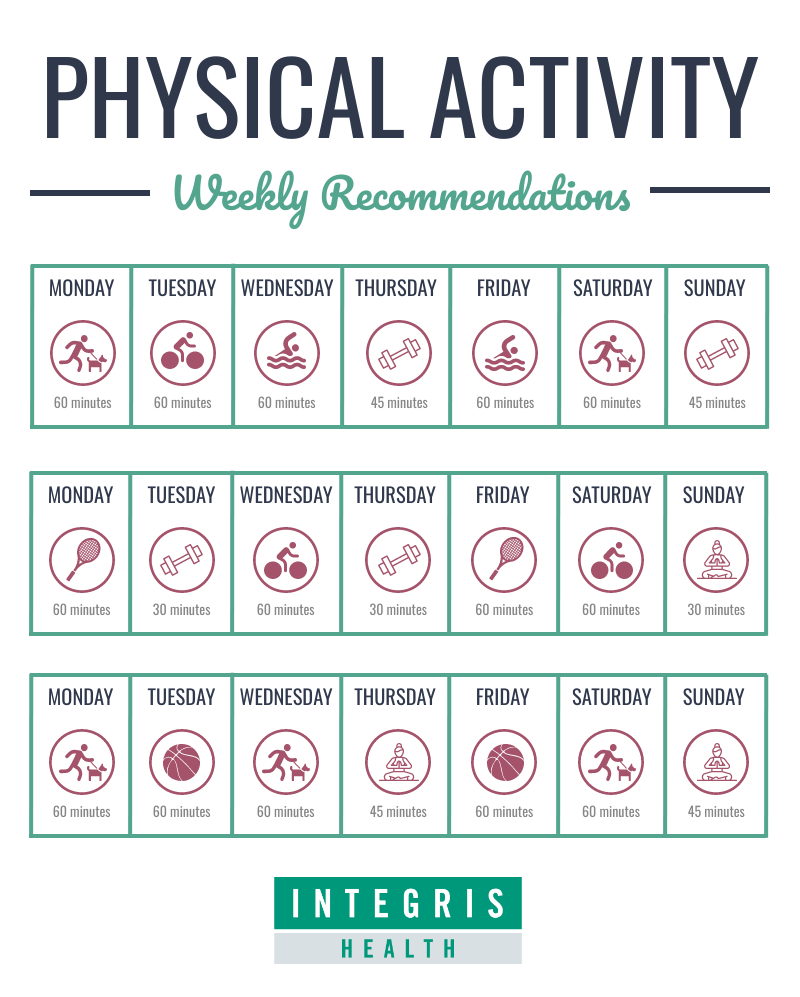How Much Physical Activity Do I Need?
Posted in

January 24-30, 2021 is National Healthy Weight Week. The New Year often encourages people to establish healthy habits, set weight loss goals or improve their diet. Healthy Weight Week is a welcome reminder that healthy eating and regular exercise should be a way of life, rather than a quick fix.
It can be hard to take the slow and steady approach to build a healthy lifestyle when we're surrounded by advertisements for crash diets and 30-day fixes promising fast results. However, when paired with a nutritious diet, regular physical activity is all you need to maintain a healthy weight and reap the many benefits of good health.
How much physical activity do you actually need? We're breaking down everything you need to know to establish healthy habits and a consistent activity level for the long term.
Benefits of regular physical activity
Modern life lends itself to a rather sedentary daily routine. Most people sit all day for work, and then come home and engage in sedentary activities to unwind. While we can't quit our desk jobs, it's essential to understand that a sedentary lifestyle poses several health risks, such as heart disease, diabetes and obesity.
Exercise is not just about weight loss. Establishing a routine of regular physical activities has tremendous physical, mental and emotional benefits. Plus, it can undo the effects of a previously sedentary lifestyle.
The following are some of the many benefits of regular physical activity.
- More easily maintain a healthy weight
- Reduce risk of heart disease
- Lower risk of type 2 diabetes and some cancers
- Lower blood pressure and cholesterol
- Stronger bones, muscles and joints
- Lower risk of developing osteoporosis
- Improved brain health
- Lower risk of fall-related injuries
- More energy, better mood and reduced stress
- Better sleep
- Positive self image
Types of physical activity
There are two main types of physical activity you should incorporate into your routine: aerobic and muscle-strengthening exercises.
Aerobic activity is anything that increases your heart rate. Aerobic exercise can be moderate or vigorous in intensity and includes activities such as biking, swimming, walking or playing recreational games. Even chores such as gardening or raking leaves can count as aerobic activity.
Muscle-strengthening activities can include lifting weights, body weight exercises or even yoga. Muscle-strengthening activities should involve all of the major muscle groups in your body including your legs, core, back, chest and arms.
It's important to note that many activities can be both aerobic and muscles strengthening. Don't be afraid to mix up your exercise modalities to challenge your body to move in a variety of ways and avoid feeling burnt out.
Physical activity guidelines for adults
According to guidelines from the U.S. Department of Health and Human Services adults should engage in moderate-intensity aerobic activity for two to five hours per week, in addition to 1.5 hours of vigorous-intensity aerobic activity preferably spread out throughout the week. It's also recommended to participate in muscle-strengthening activities involving all major muscle groups at least twice every week.
Spreading out your physical activity into smaller daily blocks makes it easier to be consistent. We've outlined a few examples of what a weekly activity routine could look like in the graphic below. Included are activities such as walking your dog, swimming, biking, playing tennis, lifting weights, yoga and playing basketball.
When establishing a regular physical activity routine, remember to choose activities you enjoy so it's easier to stay consistent over time. You can also ask a friend or family member to join you. This not only makes it more fun, it also helps you stay accountable.
Tips for safe physical activity
If you're trying a new physical activity, it's important to be safe! Always choose activities that are appropriate for your current fitness level to avoid overdoing it or causing injury. You can start with just five minutes of physical activity per day if that's what feels best for you. Remember, something is better than nothing. Aim for consistency over perfection.
If you are playing a sport, wear the appropriate protective gear or equipment, such as a helmet, goggles, knee or elbow pads or mouth guard. If you are pregnant or have a chronic health condition, talk to your healthcare provider to make sure your physical activity level is appropriate for you.
Engaging in regular physical activity has so many benefits for your body and mind. Start slow, have fun and remember that five minutes of activity is better than nothing. For more healthy tips, read our On Your Health blog.




